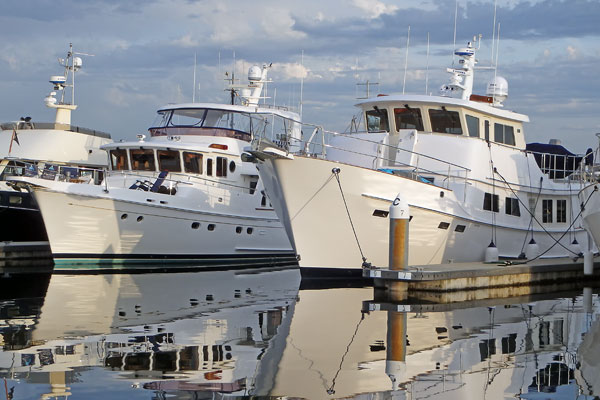In the truest sense a trawler is a fishing vessel, very stout and heavy with high deck railings capable of heading out into the ocean to catch vast holds of fish and return to port safely. The “trawler market” for production built recreational power boat models was not launched until the 1960’s by Grand Banks Yachts.
Grand Banks Yachts built a series of “trawler style” power boats that opened up an attractive cruising options. Its greatest appeal was to sailors who were “aging-up” and wanted to still spend time on the water without the hassle of sails and lines. Other companies, many of whom started out creating sailboats, followed suit. By the 1990’s a wide variety of builders like Kadey-Krogen, Nordhavn, Sabre, Fleming and dozens of others spawned a huge boom in trawler options with designs ranging from coastal cruisers to ocean crossing passage makers. Now, there are fast planing trawlers skimming over the surface of the water at speeds over twenty knots and full displacement hulls plowing the seas 24/7 for weeks at a time. As more and more buyers caught the bug, the transition from strictly monohulls to the inclusion of trawler catamarans evolved. This was all popularized in the boating publications, with special credit given to PassageMaker magazine for opening the door and broadcasting the parade. Initially, PassageMaker was focused on full displacement long range trawlers, but also called to attention the growing demand for “trawlers” to include tugs, multi-hulls. This growing demand brought about a new trawler definition, “Any power boat that is comfortable to cruise on for the amount of time her owners desire to be out boating”. Sure, there is a “trawler look”, even a “tug look”, but if it isn’t a sport fishing boat (although even some of those are ”trawlers”) then the very broad term TRAWLER will apply.
There is a multitude of trawlers to choose from. Your search for the perfect trawler will be more productive if you develop a method to narrow your choices. Even if you don’t have a set budget in mind (yet), the cost to purchase, upgrade, and maintain your trawler is probably the single biggest limiting factor. You need to have some sense of the price range you can comfortably afford. After establishing your budget, you need to determine how much space you need. For most trawler owners a two stateroom, two head boat is all they need – it’s typically two people spending the bulk of their time together on board with friends and family visiting (and that is where the other stateroom comes into play). If you intend to have a trawler large enough that it will require a captain and crew to maintain it then you want to look at trawlers large enough to provide the staff reasonable accommodations while also providing a separation of space between family/guests and crew.
This gets back to one of the chief decisions you need to consider, what type of cruising do you intend to do? There are different requirements for coastal meandering versus extended voyages involving ocean crossings. Knowing what type of traveling you want to do will also greatly influence your selection. If you plan to stay close to home and use your trawler mainly on weekends, a faster trawler that will deliver you to your get away destination Friday afternoon and home in time Sunday evening may be your best option. As you contemplate these questions you will develop a “decision tree” – either mentally or by formally writing something down on paper to “map out” your thinking and create a guide to help you decide the type of trawler that best suits your lifestyle and cruising desires.

